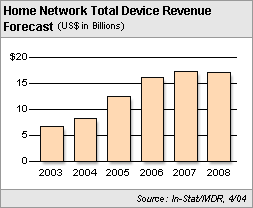Report: Home Networking market to reach $17.1 Billion in 2008
May 10, 2004 — by LinuxDevices Staff — from the LinuxDevices Archive — viewsHome networking entered the mainstream in 2003 and early 2004, as large numbers of broadband users installed home networks to share Internet connections, and electronics vendors delivered new products to send high-value entertainment content over the network, according to market analyst firm In-Stat/MDR. The continued need for broadband sharing and a growing interest in entertainment networking will drive the total value of equipment with a home networking connection of some type from $8.3 billion in 2004 to $17.1 billion by 2008.
 “The emergence of media networking continues to be the most exciting part of the home networking market,” according to Mike Wolf, Principal Consumer Connectivity and Content Analyst with In-Stat/MDR. “Many vendors have announced or released media networking products to connect entertainment devices to networks in order to share audio and video content around the home. We expect Microsoft's Media Center Extender technology to accelerate this trend going forward into 2005.”
“The emergence of media networking continues to be the most exciting part of the home networking market,” according to Mike Wolf, Principal Consumer Connectivity and Content Analyst with In-Stat/MDR. “Many vendors have announced or released media networking products to connect entertainment devices to networks in order to share audio and video content around the home. We expect Microsoft's Media Center Extender technology to accelerate this trend going forward into 2005.”
In-Stat/MDR also found that:
- Asia will eclipse North America for the region with the most home networks by 2008, rising from 27% of all home networks worldwide in 2004 to 36% in 2008, with North America dropping from 46% to 34% in the same time span.
- The wireless LAN market has evolved from being 802.11b dominated to one where 802.11g and multi-band 802.11 represented nearly 50% of shipments in the fourth quarter of 2003.
- New technologies such as MIMO and wireless 1394 will make WLAN technology an increasingly viable alternative for multimedia networking.
- In-Stat/MDR's consumer surveys show retail storefronts have become the dominant place for purchasing home networks, while on-line shopping has declined in importance.
- Linksys was the leading vendor of media adapters in 2003, while network disk vendor Ximeta led the emerging market for consumer network storage.
In-Stat/MDR found the entertainment content that people consume will increasingly be delivered to the home over a variety of broadcast and IP-based channels, then redistributed over some form of network once in the home. “Comcast's recent announcement of their home network gateway initiative and multi-room PVR efforts by Echostar and other service providers show how the home network will be a central delivery and content consumption platform in the future,” said Wolf.
The report, Digital Domicile 2004: Home Networking Hits the Big Time (#IN0401227RC), contains extensive analysis using consumer survey data, vendor profiles, and detailed forecasting. In each market segment In-Stat/MDR examines the key players, including ingredient technology vendors. Forecasts are broken down by product segment, as well as LAN interface. Included are market shares for home routers, residential gateways, media adapters, networked cameras, home network central storage, wireless LAN, HomePlug and HomePNA. Also included are detailed forecasts of home routers, residential gateways, media networking, LAN Interfaces (WLAN, Ethernet, HomePlug, HomePNA, Coax/MoCA, 1394), worldwide and regional home networks and home media networks.
Copyright © 2004 In-Stat/MDR. Reproduced with permission by LinuxDevices.com
This article was originally published on LinuxDevices.com and has been donated to the open source community by QuinStreet Inc. Please visit LinuxToday.com for up-to-date news and articles about Linux and open source.